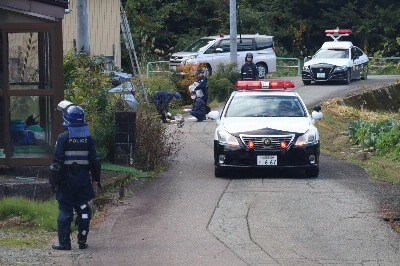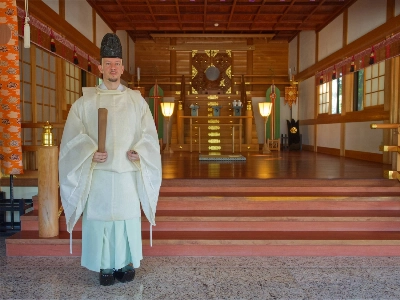By C.W. NICOL
W hich other island nation's coasts have sea ice in the north and corals in the south? Japan's climate is also hugely influenced by a great continental mass on one side, a sea in between to moderate temperatures and pick up moisture and, to the other side, the vast Pacific Ocean.
The northerly coasts of Hokkaido, where winter ice pushes down from the Sea of Okhotsk, have huge deciduous trees and vines of wild grapes, mixing in with conifers. In fact, within a few decades of Japan opening its ports to foreign vessels in the mid-19th century, one of the major exports was a species of oak (Quercus crispula) that was in great demand for expensive coffins, furniture and barrels.
With plentiful snow and rain, volcanoes that have frequently covered the land with mineral-rich ash, and a wide range of climates, Japan is blessed with a remarkable variety of trees and other forest growth. In the most southerly islands, such as Iriomote in Okinawa, you find semitropical jungle. On Yaku Island off southern Kyushu, you get massive cedars, or cryptomeria (Cryptomeria japonica). On Yaku Island they call any cedar less than 1,000 years old ko-sugi (baby cedar), and they claim that the oldest on the island, named Jomon Sugi, is more than 7,000 years old.
When I began hiking in the Japanese mountains back in 1963, I was awed by the magnificent virgin beech woods that seemed like high, leafy cathedrals of green, full of the sounds of running water and birds. As someone born and raised in Britain, where wild bears were exterminated around the 10th century, I was delighted to discover that two species of those mighty mammals still roamed Japan's woods, together with wild boar, deer, serow (goat antelopes) and many other creatures both large and small.
However, since I first came to live in northern Nagano Prefecture in 1980, the decline in the quality and health of Japanese woodland has been a constant concern, and something to which I have devoted a major part of my life.
Twenty-one years ago, I began buying up parcels of neglected mixed woodland near my home, together with spindly plantations of Japanese larch and cedar. Three years after that, I finally persuaded a local forester to work full time with me to restore these woods to healthy biodiversity. Then, three years ago, we formed a trust to expand and manage the woods, and to ensure their future. The work and study has been constant, but we are always making progress. Indeed, just last month we acquired more adjoining woodland that is at present filled with tangled scrub and spindly trees that have pretty well stopped growing. That means we have a lot more (extremely satisfying) work to do in biological cataloging and assessment, then trimming, thinning and probably replanting.
Nationwide, about 70 percent of Japan's total land area is woodland, though less than 2 percent of this is natural old-growth or virgin forest. In the 40-odd years since I first came to Japan, these old-growth forests have been ravaged to extract timber with which to pay the salaries and expenses of those working for what was then the Forestry Agency and is now the Ministry of Agriculture, Forestry and Fisheries. Shamefully, to this day less than 10 percent of the ministry's budget is spent on forest maintenance. The jobs of what I call "real foresters" -- those folk who actually go out and work in the woods to make their own living -- have been systematically cut back by the government to the point where nowadays, 100 percent of actual logging, 90 percent of planting and 80 percent of weeding is contracted out.
Dereliction of duty
Bureaucrats support bureaucrats, and produce prodigious volumes of paperwork -- but they do little if any real work in the woods. In fact, in 20-odd years working in our woods bordering a national forest here, I know that the only work on that state property has been done under the direction of Nobuyoshi Matsuki, our trust's forester, by volunteers from a college I helped to set up. That is even though that woodland, like so many others, is mostly made up of cedars that have not been thinned or tended for decades, and are consequently spindly and of little value.
Such dereliction of duty is on a monumental scale, since -- according to the ministry's "Annual Report on Trends of Forest and Forestry, Fiscal Year 2003" -- national forests comprise 30 percent of Japan's total woodland, covering some 7.8 million hectares, often in remote mountain ranges and headwater areas. Meanwhile, according to the same source, municipal forests cover another 1.6 million hectares; prefectural forests some 1.2 million hectares; and private forests 14.5 million hectares.
However, just as the bureaucrats are absentee landlords, the numbers of private forest owners who don't live in the same municipality as their woodland is rising. Now, it is now almost a quarter of the total. Very few indeed of these people take any care of their woods. Most have inherited them, and most simply consider their value in terms of what they could get for the land if they sold it.
But such neglect is not even confined to absentee landlords. When I first bought land and built a house here outside Kurohime 23 years ago, I both trimmed and planted trees to landscape my plot. The land next door had trees of a similar age and mix as ours, but now the difference is remarkable. Our trees are thick and vigorous and still growing. Our neighbor's trees have hardly grown at all, and are sick and spindly. Even though the neighbor is a local, neither she nor her grown son have shown any interest at all in tending or improving their woods. I can glance over my shoulder through one of the windows in my study right now and look at those crowded trees. The thickest are about as thick as my neck, most are only as thick as my arm. Our stoutest trees, of the same age but tended, are now as thick around as my 65-year-old belly -- and fine figures of trees they are, might I say!
Why has this neglect of forest occurred?
Well, for one thing, the stumpage price (what's paid for a tree before it is cut down, moved out and processed) of Japanese cedar, by far the most common of planted trees in Japan, is only one fifth of its peak price in 1980. This reflects the fact that the volume of timber consumption per capita in 2002 had fallen to a third of the peak volume in 1973, due mainly to an increased use of concrete and steel in buildings, with many traditional homes in cities being knocked down to make way for apartment complexes, which helped pay for exorbitant death taxes. Then, of course, there has also been the rising value of the yen against other world currencies, and an eager willingness on the part of other countries, either legally or illegally, to see their forests sold off.
If you plant conifers close together and then don't tend them regularly, they grow until the upper canopy closes off the light. Lower branches then die on the trunk. On the forest floor, light-deprived vegetation becomes weak and poor, rendering steep slopes more liable to erosion and landslips. The trees themselves, meanwhile, denied sufficient sunlight or goodness in the soil, pretty well stop growing. Add to this blighted brew a lot of insect- and fungus-ridden specimens -- including the millions of dead standing pines all over Japan -- and what you have is a serious danger of forest fires.
Similarly, widespread and long-standing neglect of Japan's mixed-wood forests -- managed for centuries for quality hardwoods, nuts, fruits, mushrooms, natural medicines and wild vegetables, as well as for game birds such as pheasants and game animals from bears to hares, together with leaf mulch for fertilizer and timber for firewood and charcoal -- does not bring a romantic "return to nature." Left alone, for example, trees long coppiced in these woodlands so their stumps would grow new stems that were trimmed out for traditional and renewable uses, become crowded and prone to sickness. In such crowded conditions, too, the many species of vines in Japan can easily spread from tree to tree, strangling stems and trunks. Also, such spindly tree stems, top heavy with vines, very often break with the weight of snow.
Then, when natural forest is clear-cut in Japan, a quick covering of bamboo grass, which inhibits other growth, tends to move in to fill the ecological niche. (Those strange bits of green plastic in sushi boxes replaced bamboo grass leaves, which were traditionally used to help keep the food fresh. The plastic, of course, does nothing but add to the nation's garbage mountain.) The result is that this dense growth of bamboo grass permits only trees that have a head start from their stumps to grow, while preventing most other flowers and trees that grow from seeds or roots to flourish.
The upshot is that neglected mixed woods turn to dense scrubby brush, with decreased biodiversity, and an increased danger of fires.
Another more recent and particular danger is that with the decline in the fruitfulness of their forest habitats, bears now often come out to feed from fields and orchards, and to loll around in neglected woodlands close to human habitations. Consequently, more dangerous bear encounters have occurred in the last 20 years than ever before. And ironically, many country folk -- the same ones who have inherited and neglected their own woodlands -- are among the first to blame the bears and demand their extermination.
Forest neglect, along with the problem of global climate change and air pollution blowing across to Japan from an increasingly industrialized China, is fast worsening the acidity of woodland soils and the ability of the trees themselves to withstand disease. Recently, a blight of oak trees, brought about by a fungus-carrying beetle, has killed thousands, or perhaps millions, of oaks along the Sea of Japan side of the archipelago. Now, that fatal blight is spreading inland and is within less than 20 km of our forest.
Relaxing fragrance and warmth
But all is not dark and dank and gloomy in the forests of Japan. For all the craven neglect, there is also an increasing awareness in many quarters of the need for healthy woodlands. Millions now suffer from "sick house" syndrome, thought to be caused by the adhesives and plastics used in construction. Natural wood is being viewed as a cure for this, as well as a way of investing properties with a relaxing fragrance and warmth that makes them more comfortable to live in. Indeed, the above-mentioned ministry report states that the majority of respondents to a government survey recognized that "'wood feels cool in summer and warm in winter." Also, it showed that the number of people who believed that wood and wood products were better for medical, welfare and child-care facilities has risen by 10 percent over the previous survey.
Coupled to this, the use of wood in public buildings is on the increase, and has grown from 4 percent to 10 percent in the last 10 years. Research into forest-product use, originating both in Japan and abroad, is very encouraging, even for this old woodsman. Commendable work is being done on increased fire resistance, the use of laminated lumber of various types, and the production of wood plastic from natural lignin and wood fibers, as well as a biodegradable plastic made by the fermentation and processing of cellulose.
Volunteer forestry groups are also experiencing a welcome upsurge in Japan these days, with their number rising from 277 in 1997 to 1,165 in 2003. Among them, too, a very interesting development is that many are working in partnership with fisheries groups, as more and more people get the message that healthy forests assist the maintenance of healthy rivers, which in turn improve coastal fisheries. Even so, the population of active foresters (the ministry calls them "forest laborers") had dropped to 67,000 in 2000, a 60 percent decrease from 10 years before.
One of those axed from their work in the woods -- most of whom are drawn into the construction industry after being fired or not re-hired by the Forest Agency -- would have been our precious forester, Matsuki-san. Now 70 years old, he is a true expert, who first went to work with his father making charcoal at age 15, and later became adept in all aspects of a forester's job. Matsuki-san knows more practical stuff about woods than all the government men I've ever met, and more than most forestry professors, too. Once skills and lore like his are lost, it becomes an uphill -- and expensive -- job to educate the tens of thousands needed to tend Japan's woodlands well.
Though city-dwellers might not realize it, mountain villages and small rural municipalities encompass fully half of Japan's total land area -- and these communities have 90 percent of their land covered in trees of some kind. Obviously, if such habitations are to survive, their residents need to be able to make a living maintaining forests for their water conservation, lumber, wildlife, education, health care, tourism and many other qualities.
Symposium-ed half to death
Faced with this national arboreal crisis, much has been written and many (myself included) have been symposium-ed half to death about what should be done. All kinds of plans get drawn up. Woodlands are designated as "interaction forests," "forests to support the culture of wood" -- and even as "corporation forests." Bureaucrats encourage volunteer groups and come up with fancy graphs and reports. All very well and good, but until serious money is diverted to forests, and to the fieldworkers who have the real expertise and knowledge, then we'll continue to have aberrations such as little watershed valleys being used to dump industrial and medical waste, and neglected woodland drifting dangerously close to erosion or forest fire. Oh, and then there's also the business of rampant poaching of rare plants, insects and whatever else can be stolen from the nation's untended woods to make a little money.
In short, until the whole nation gets serious -- and stops thinking about trees just in terms of cherry-blossom-viewing parties or a trip to see the autumn colors -- then the most to be hoped for will be small improvements in localized areas like our small woods here in Kurohime. And that's not something for Japan to be proud of, either at home or as an example for its Asian and Pacific neighbors.






















With your current subscription plan you can comment on stories. However, before writing your first comment, please create a display name in the Profile section of your subscriber account page.